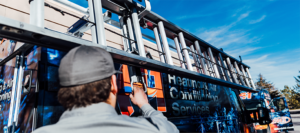
CIANDRA CAMACHO
A Complete Guide
As the temperatures begin to drop, it’s time to start thinking about preparing your home for the colder months ahead. One of the most important tasks on your fall to-do list should be prepping your HVAC system for winter. Proper preparation not only ensures your comfort throughout the season but also helps improve your system’s efficiency and longevity. At A-1 Heating and Air Conditioning Services, we want to help you get your home winter-ready with these simple HVAC tips.
Schedule a Professional
Maintenance Check:
Before the winter chill sets in, schedule a professional maintenance check with a qualified HVAC technician. A professional inspection will ensure that all components of your heating system are in
good working order. The technician will:
-
- Inspect and Clean the Furnace: Check for any signs of wear or damage, including cracks in the heat exchanger, which could lead to carbon monoxide leaks.
- Clean or Replace the Air Filter: A dirty filter can restrict airflow, reducing your system’s efficiency and increasing energy costs.
- Check Thermostat Settings: Ensure your thermostat is calibrated correctly and functioning properly to maintain a consistent indoor temperature.
Replace or Clean Your Air Filters:
Changing your HVAC filters is one of the easiest yet most crucial tasks in preparing your system for winter. Over time, filters become clogged with dust, pollen, and other debris, making it harder for your system to circulate air efficiently. A clean filter:
- Improves Air Quality: Prevents allergens and dust from circulating through your home.
- Enhances Efficiency: Allows for better airflow, which reduces the strain on your system and lowers energy consumption.
- Extends System Lifespan: Reduces wear and tear, helping to prevent costly breakdowns.
Seal and Insulate Your Home
Proper insulation is key to keeping your home warm and your energy bills low. Check for drafts around windows, doors, and other openings. Use weather stripping, caulk, or foam insulation to seal any gaps or leaks. In addition to keeping your home comfortable, sealing drafts can:
- Reduce Heat Loss: Prevent warm air from escaping and cold air from
entering, maintaining a stable indoor temperature. - Improve System Efficiency: Reduce the workload on your HVAC
system, lowering energy consumption.
Test Your Thermostat
As the weather cools down, it’s essential to test your thermostat to ensure it is working correctly. Consider upgrading to a programmable or smart thermostat, which can:
- Optimize Energy Usage: Set specific temperatures for different times of the day, reducing energy waste when you’re not home.
- Improve Comfort: Maintain a consistent indoor temperature, ensuring comfort throughout your home.
Test Your Carbon Monoxide Detectors
Your HVAC system can produce carbon monoxide, a colorless, odorless gas that can be harmful if it accumulates indoors. Make sure to:
- Test Detectors: Ensure all carbon monoxide detectors in your home are working correctly.
- Replace Batteries: Change the batteries every six months, or as needed.
- Place Detectors Properly: Install detectors near sleeping areas and on every level of your home.
Consider Upgrading Your System
If your HVAC system is over 10-15 years old or has required frequent
repairs, it may be time to consider an upgrade. A new, energy-efficient
system can:
- Reduce Energy Costs: Save money on heating bills through improved efficiency.
- Enhance Comfort: Provide more consistent heating throughout your home.
- Increase Home Value: Add value to your property by investing in a modern, efficient heating system.


